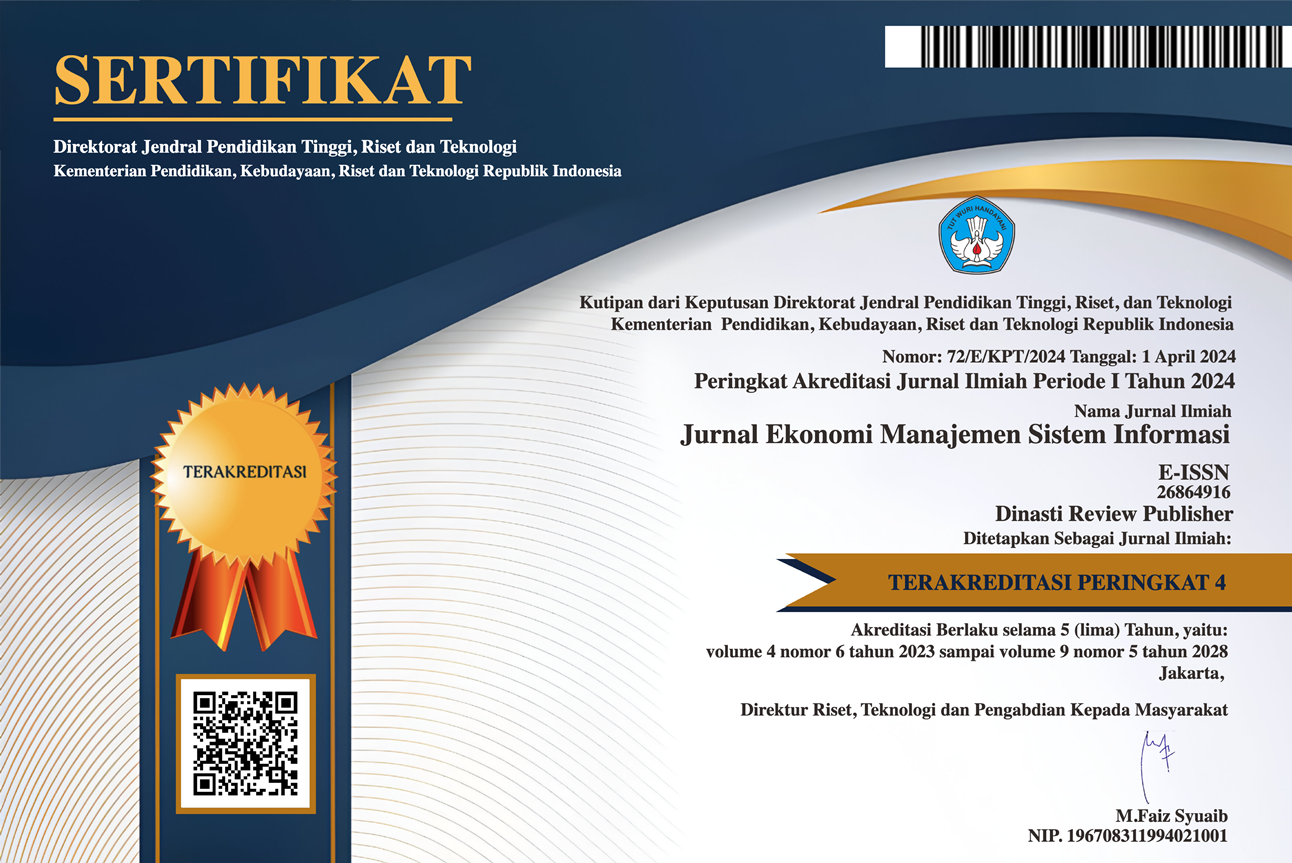Manajemen Strategis dan Kerangka Kerja Strategis
DOI:
https://doi.org/10.31933/jemsi.v5i3.1850Keywords:
Strategic Planning, Strategy Formulation, Strategy Implementation and Strategy Evaluation, Strategic Framework, Seizing Market Opportunities, Products Competitive, Winning the Competition, Organization Survives for the Long Term LongAbstract
During these years, strategic planning was widely believed to be the answer to all problems. At that time, most major companies in large countries like the United States were obsessed with strategic planning. However, after the “boom”, strategic planning was put aside in the 1980s because various planning models did not provide higher results. However, the 1990s brought a renaissance of strategic planning, and the process is widely practiced today in the business world. The strategic plan need a plan which is good so that companies have the opportunity to compete successfully. Strategic consists of three stages: strategy formulation, strategy implementation, and strategy evaluation. Strategy formulation includes developing a vision and mission, identifying the organization's external opportunities and threats, determining internal strengths and weaknesses, setting long-term goals, generating alternative strategies, and selecting specific strategies to implement. Strategy formulation issues include deciding what new businesses to enter, what businesses to abandon, how to allocate resources, whether to expand operations or diversify, whether to enter international markets, whether to merge or form a joint venture, and how to avoid hostility. takeover. Because no organization has unlimited resources, strategists must decide which alternative strategies will most benefit the company. Strategy formulation decisions commit an organization to specific products, markets, resources, and technologies over a long period of time. Strategy determines long-term competitive advantage. Good or bad, strategic decisions have major multifunctional consequences and long-lasting effects on organizations. Top managers have the best perspective to fully understand the consequences of strategy formulation decisions; they have the authority to allocate the resources necessary for implementation. Strategy implementation requires companies to set annual goals, design policies, motivate employees, and allocate resources so that the formulated strategy can be implemented. Strategy implementation includes developing a culture that supports the strategy, creating an effective organizational structure, directing marketing efforts, preparing budgets, developing and utilizing information systems, and linking employee compensation to organizational performance. Strategy implementation is often called the “action stage” of strategic management. Implementing a strategy means mobilizing employees and managers to put the formulated strategy into action. Often considered the most difficult stage in strategic management, strategy implementation requires personal discipline, commitment, and sacrifice. Successful strategy implementation depends on the manager's ability to motivate employees, which is more art than science. Strategies that are formulated but not implemented serve no useful purpose. Strategy implementation activities affect all employees and managers in an organization. Each division and department must decide the answer to questions, such as “What should we do to implement our part in the organization's strategy?” and “What is the best way to get this job done?” The challenge of implementing it is to stimulate managers and employees throughout the organization to work with pride and enthusiasm in achieving the set goals. Strategy evaluation is the final stage in strategic management. Managers really need to know when a particular strategy is not working; Strategy evaluation is the primary means of obtaining this information. All strategies are subject to modification in the future as external and internal factors continue to change. The three fundamental strategy evaluation activities are (1) reviewing the external and internal factors on which the current strategy is based, (2) measuring performance, and (3) taking corrective action. Strategy evaluation is necessary because today's success is no guarantee of tomorrow's success! Success always creates new and different problems; complacent organizations die. Strategy formulation, implementation, and evaluation activities occur at three hierarchical levels in a large organization: corporate, divisional or strategic business units, and functional. By fostering communication and interaction between managers and employees across hierarchical levels, strategic management helps companies function as competitive teams. Most small businesses and some large businesses do not have divisions or strategic business units; they only have corporate and functional levels. However, managers and employees at both levels must be actively involved in strategic management activities.
References
Fred R. David Francis Marion University Florence. South Carolina Strategic Management Concepts and Cases.
Thirteenth Edition, Chapter 9 Strategy Review, Evaluation, and Control.
High Performance Business Strategy. Inspiring Success Through Effective Human Resource Management. Ap Eigenhuis.Rob Van Dijk, 2007
Kathy Kiely. Para Pejabat Mengatakan CEO Otomotif Harus Spesifik dalam Rencananya. USA Today (24 November 2008): 3B.
Peter Drucker, Manajemen: Tugas, Tanggung Jawab, dan Praktek. New York: Harper & Row. 1974: 611.
Alfred Sloan, Jr., Petualangan Pria Kerah Putih (New York: Doubleday, 1941): 104.
Dikutip dalam Eugene Raudsepp, “Dapatkah Anda Mempercayai Anda Firasat?” Tinjauan Manajemen 49, no. 4 (April 1960): 7.
Stephen Harper, “Intuisi: Apa yang Memisahkan Eksekutif dari Manajer,” Business Horizons 31, no. 5 (September – Oktober 1988): 16.
Ron Nelson, “Bagaimana Menjadi Manajer,” Sukses (Juli – Agustus 1985): 69.
Bruce Henderson, Henderson tentang Strategi Perusahaan(Boston: Abt Books, 1979): 6.
Robert Waterman, Jr., Faktor Pembaruan: Bagaimana yang Terbaik Mendapatkan dan Mempertahankan Keunggulan Kompetitif (New York: Bantam, 1987). Lihat juga BusinessWeek (14 September 1987): 100. Lihat juga Akademi Manajemen Manajemen 3, no. 2 (Mei 1989): 115.
Jayne O'Donnell, “Pembeli Berbondong-bondong ke Toko Diskon,” USA Today (25 Februari 2009): B1.
Ethan Smith, “How Old Media Can Survive in a New World,” Wall Street Journal (23 Mei 2005): R4.
Daniel Delmar, “The Rise of the CSO,” Desain Organisasi (Maret–April 2003): 8–10.
John Pearce II dan Fred David, “Intinya Pernyataan Misi Perusahaan,” Academy of Management Executive 1, no. 2 (Mei 1987): 109.
Fred R. David, “Bagaimana Perusahaan Mendefinisikan Misinya,” Perencanaan Jangka Panjang 22, no. 1 (Februari 1989): 91.
Jack Pearce dan Richard Robinson, Manajemen Strategis, edisi ke-7. (New York: McGraw-Hill, 2000): 8.
Ann Langley, “Peran Perencanaan Strategis Formal,” Perencanaan Jangka Panjang 21, no. 3 (Juni 1988): 40.
Bernard Reimann, “Mendapatkan Nilai dari Perencanaan Strategis,” Tinjauan Perencanaan 16, no. 3 (Mei – Juni 1988): 42.
GL Schwenk dan K. Schrader, “Pengaruh Formal Perencanaan Strategis dalam Kinerja Keuangan di Perusahaan Kecil: Sebuah Meta-Analisis,” Kewirausahaan dan Praktek 3, no. 17 (1993): 53–64. Juga,
CC Miller dan LB Cardinal, “Perencanaan Strategis dan Kinerja Perusahaan: Sintesis Penelitian Lebih dari Dua Dekade,” Jurnal Akademi Manajemen 6, no. 27 (1994): 1649–1665;
Michael Peel dan John Bridge, “Bagaimana Perencanaan dan Penganggaran Modal Meningkatkan Kinerja UKM,” Perencanaan Jangka Panjang 31, no. 6 (Oktober 1998): 848–856;
Julia Smith, “Strategi untuk Start- Up,”Perencanaan Jangka Panjang 31, no. 6 (Oktober 1998):857–872.
Gordon Greenley, “Apakah Perencanaan Strategis Meningkatkan Kinerja perusahaan?" Perencanaan Jangka Panjang 19, no. 2 (April 1986): 106. Diadaptasi dari www.mindtools.com/plreschn.html.
Dale McConkey, “Planning in a Changing Environment,”
Cakrawala Bisnis (September–Oktober 1988): 66 RT Lenz, “Mengelola Evolusi Proses Perencanaan Strategis,” Business Horizons 30, no. 1 (Januari–Februari 1987): 39.
Frederick Gluck, “Menghilangkan Mistik dari Perencanaan,” Secara Keseluruhan (Juli – Agustus 1985): 59.
Downloads
Published
How to Cite
Issue
Section
License
Copyright (c) 2024 Sumaryono, Zahara Tussoleha Rony

This work is licensed under a Creative Commons Attribution 4.0 International License.
Hak cipta :
Penulis yang mempublikasikan manuskripnya di jurnal ini menyetujui ketentuan berikut:
- Hak cipta pada setiap artikel adalah milik penulis.
- Penulis mengakui bahwa Jurnal Ekonomi Manajemen Sistem Informasi (JEMSI) berhak menjadi yang pertama menerbitkan dengan lisensi Creative Commons Attribution 4.0 International (Attribution 4.0 International CC BY 4.0) .
- Penulis dapat mengirimkan artikel secara terpisah, mengatur distribusi non-eksklusif manuskrip yang telah diterbitkan dalam jurnal ini ke versi lain (misalnya, dikirim ke repositori institusi penulis, publikasi ke dalam buku, dll.), dengan mengakui bahwa manuskrip telah diterbitkan pertama kali di Jurnal Ekonomi Manajemen Sistem Informasi (JEMSI).










































































